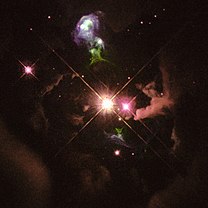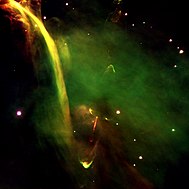Herbig–Haro object
Herbig–Haro (HH) objects are bright patches of
First observed in the late 19th century by
Discovery and history of observations
The first HH object was observed in the late 19th century by Sherburne Wesley Burnham, when he observed the star
Following their independent discoveries, Herbig and Haro met at an astronomy
An image of a question mark associated with the object was reported on 18 August 2023 in The New York Times.[5]
Formation
Stars form by gravitational collapse of
Properties

Electromagnetic emission from HH objects is caused when their associated
The total mass being ejected by stars to form typical HH objects is estimated to be of the order of 10−8 to 10−6 M☉ per year,[17] a very small amount of material compared to the mass of the stars themselves[20] but amounting to about 1–10% of the total mass accreted by the source stars in a year.[21] Mass loss tends to decrease with increasing age of the source.[22] The temperatures observed in HH objects are typically about 9,000–12,000 K,[23] similar to those found in other ionized nebulae such as H II regions and planetary nebulae.[24] Densities, on the other hand, are higher than in other nebulae, ranging from a few thousand to a few tens of thousands of particles per cm3,[23] compared to a few thousand particles per cm3 in most H II regions and planetary nebulae.[24]
Densities also decrease as the source evolves over time.
Numbers and distribution
HH objects are named approximately in order of their identification; HH 1/2 being the earliest such objects to be identified.[25] More than a thousand individual objects are now known.[8] They are always present in star-forming H II regions, and are often found in large groups.[10] They are typically observed near Bok globules (dark nebulae which contain very young stars) and often emanate from them. Several HH objects have been seen near a single energy source, forming a string of objects along the line of the polar axis of the parent star.[8] The number of known HH objects has increased rapidly over the last few years, but that is a very small proportion of the estimated up to 150,000 in the Milky Way,[26] the vast majority of which are too far away to be resolved. Most HH objects lie within about one parsec of their parent star. Many, however, are seen several parsecs away.[22][23]
Source stars
The stars from which HH jets are emitted are all very young stars, a few tens of thousands to about a million years old. The youngest of these are still protostars in the process of collecting from their surrounding gases. Astronomers divide these stars into classes 0, I, II and III, according to how much infrared radiation the stars emit.[29] A greater amount of infrared radiation implies a larger amount of cooler material surrounding the star, which indicates it is still coalescing. The numbering of the classes arises because class 0 objects (the youngest) were not discovered until classes I, II and III had already been defined.[30][29]
Class 0 objects are only a few thousand years old; so young that they are not yet undergoing nuclear fusion reactions at their centres. Instead, they are powered only by the
About 80% of the stars giving rise to HH objects are binary or multiple systems (two or more stars orbiting each other), which is a much higher proportion than that found for low mass stars on the
The first and currently only (as of May 2017) large-scale Herbig-Haro object around a proto-brown dwarf is HH 1165, which is connected to the proto-brown dwarf Mayrit 1701117. HH 1165 has a length of 0.8 light-years (0.26 parsec) and is located in the vicinity of the sigma Orionis cluster. Previously only small mini-jets (≤0.03 parsec) were found around proto-brown dwarfs.[35][36]
Infrared counterparts

HH objects associated with very young stars or very massive protostars are often hidden from view at optical wavelengths by the cloud of gas and dust from which they form. The intervening material can diminish the
In 2009 the acronym "MHO", for Molecular Hydrogen emission-line Object, was approved for such objects, detected in near infrared, by the International Astronomical Union Working Group on Designations, and has been entered into their on-line Reference Dictionary of Nomenclature of Celestial Objects. As of 2010, almost 1000 objects are contained in the MHO catalog.[39]
Ultraviolet Herbig-Haro objects
HH objects have been observed in the ultraviolet spectrum.[41]
See also
References
- .
- ^ Bibcode:1997IAUS..182....3R.
- ISBN 978-1-292-02293-2.
- doi:10.1086/183927.
- ^ Overbye, Dennis (18 August 2023). "The Biggest Question Mark in Astronomy? You're Looking at It. - Close scrutiny of a recent image from the Webb Space Telescope revealed some questionable punctuation". The New York Times. Archived from the original on 18 August 2023. Retrieved 19 August 2023.
- ISBN 978-0-521-65937-6.
- ^ ISBN 978-0333786536.
- ^ .
- ^ S2CID 118539135.
- ^ Bibcode:1996swhs.conf..491B. (HTML version)
- ^ .
- Bibcode:1978A&A....63..237D.
- .
- doi:10.1086/300548.
- doi:10.1086/323976.
- S2CID 58923690. 186.
- ^ doi:10.1071/PH920487.
- ^ S2CID 55887210.
- Bibcode:2017RMxAA..53..219R.
- ^ doi:10.1086/190754.
- doi:10.1086/174887.
- ^ Bibcode:2007prpl.conf..215B.
- ^ Bibcode:1999A&A...342..717B.
- ^ ISBN 978-0333786536.
- Bibcode:1974LicOB.658....1H.
- S2CID 121039271.
- ^ "Embedded Outflow in HH 46/47". NASA Spitzer Space Telescope. Jet Propulsion Laboratory, California Institute of Technology. December 18, 2003. Archived from the original on February 17, 2018. Retrieved February 16, 2018.
- doi:10.1086/324738.
- ^ S2CID 119714125.
- doi:10.1086/173608.
- doi:10.1086/172425.
- ISBN 9783527405596.
- ^ doi:10.1086/316865.
- doi:10.1086/381062.
- ^ "Punching Above Its Weight, a Brown Dwarf Launches a Parsec-Scale Jet". National Optical Astronomy Observatory. Retrieved 2020-03-06.
- S2CID 119080074.
- Bibcode:1995A&A...300..851D.
- S2CID 8799418.
- ^ S2CID 119306625.
- .
- S2CID 222245602, retrieved 2022-10-18
External links
- Catalogue of HH Objects at VizieR
- Animations of HH object jets from HST observations
- A Catalogue of Molecular Hydrogen Emission-Line Objects in Outflows from Young Stars: MHO Catalogue




